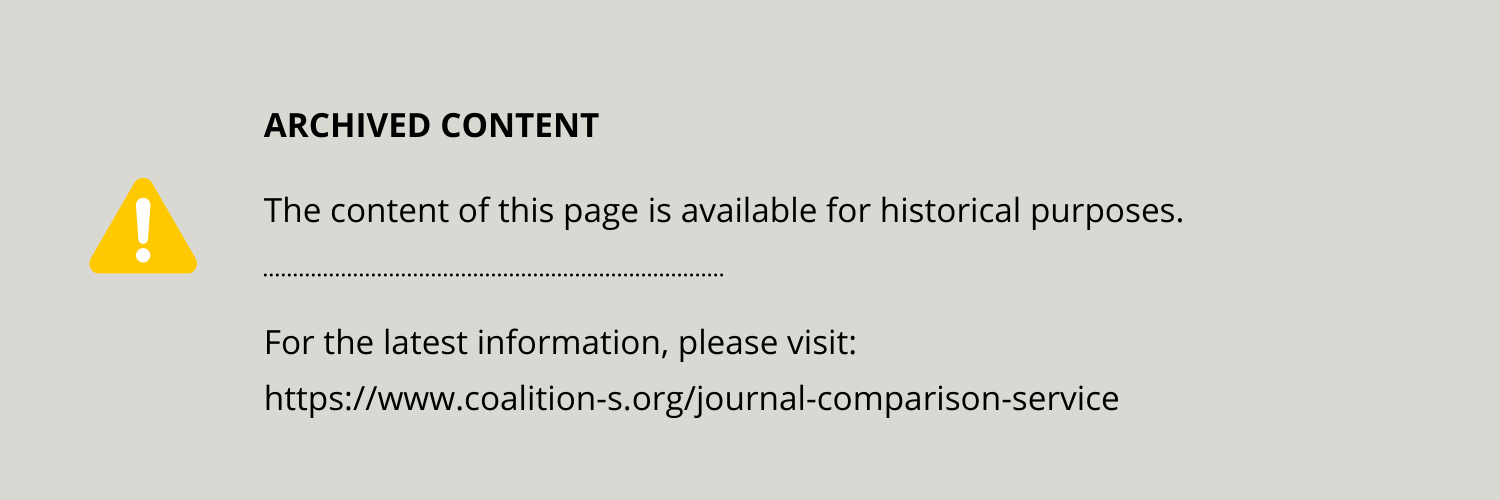Plan S Price Transparency Frameworks: guidance & requirements
[Last updated March 2022]
Background
The Guidance on the Implementation of Plan S specifies that:
Where Plan S requirements apply, no later than 1 January 2020, cOAlition S, in partnership with publisher representatives and other stakeholders, will define the various services (e.g. triaging, peer review, editorial work, copy editing) publishers will be asked to price. This price transparency requirement will apply to all articles funded through transformative arrangements as well as those levied by Open Access journals and platforms.
A draft pricing and service framework, developed by Information Power, was published in January 2020 and to help validate this – and ensure that the information sought could be provided – ten publishers (Annual Reviews, Brill, The Company of Biologists, EMBO, European Respiratory Society, F1000 Research, Hindawi, Institute of Physics Publishing, PLOS, and Springer Nature) participated in a pilot. Based on the outcomes of this – and informed by workshops and discussions – the framework has been updated and endorsed by the cOAlition S leadership. It consists of a data collection spreadsheet, an implementation guide, and recommendations.
Independent of this work, the Fair Open Access Alliance (FOAA) developed a Publication Services and Fees framework which, to date, has been implemented by Frontiers, MIT Press, Copernicus and MPDI.
Both frameworks have been endorsed by cOAlition S.
The data collection spreadsheet: Information Power
The data collection spreadsheet is in three parts:
- Part 1 seeks to collect bibliographic metadata about the journal, such as the journal name, ISSN etc, and data on list prices and waiver and discount policies.
- Part 2 looks at contextual metadata such as acceptance rate, frequency of publication and peer review times.
- Part 3 focuses on price information, and eight categories of service are identified. For each, the publisher is asked to indicate what percentage of the overall price relates to the different services provided.
The data collection spreadsheet: Fair Open Access Alliance
The FOAA framework collects data according to seven, broadly defined service baskets. Publishers have an option to extend this framework by a further three baskets, as required for their specific operations.
The Journal Comparison Service
To provide access to these data, cOAlition S is developing the Journal Comparison Service (JCS). Going live in summer 2022, this service will:
- help the research community better understand if the publishing fees they pay are commensurate with the services delivered and to gain better insight into the elements of those services;
- provide publishers with the opportunity to demonstrate their commitment to open business models and cultures, build awareness of their services and value, and build understanding and trust.
For more information, visit cOAlition S starts building its Journal Comparison Service to help create visibility of publishing services and prices and Journal Comparison Service: deadline for publisher registrations extended
Transparent pricing is a cornerstone of the Plan S principles: When Open Access publication fees are applied, they must be commensurate with the publication services delivered and the structure of such fees must be transparent. [Principle 5]
To deliver on this commitment, cOAlition S has:
1. Endorsed two Price Transparency Frameworks; the one developed by Information Power and the one developed by the FAIR Open Access Alliance;
2. Committed to build a secure, online platform (the Journal Comparison Service), where the information provided by publishers can be accessed by authorized users. The service will be accessible to publishers from May 2022, and to approved users, from late September 2022.
3. Agreed to develop the Journal Checker Tool to indicate whether a journal has provided price and service data to the JCS.
Encouraging competition for the benefit of all
We anticipate that the provision of transparent price and services information will help those stakeholders who purchase publishing services on behalf of the research community better understand the services they are procuring from publishers, and thus introduce more competition in the scholarly publishing market.
We are mindful that this joint effort towards more transparency rests on the buy-in of all parties involved. We are therefore attentive to the specific regulatory requirements with which publishers need to comply.
To this end, the service has been developed in a way that ensures that a publisher can never access another publishers’ data, and that authorized users understand – via a legally binding agreement – the commercially sensitive nature of these data and that these data cannot be shared.
Conclusion & next steps
The price and service information we seek from publishers will help publishers’ customers better understand if the fees they pay are commensurate with the open publication services delivered, and to better understand the elements of those services, for example, peer review, editorial work, and publishing infrastructure. Institutions will be able to use these data to inform discussions with researchers, for example, to offer advice to them about their publishing options.
Providing this information is also an opportunity for publishers to demonstrate their commitment to open business models and business cultures, to build awareness of their services and value, to build trust with their customers and to be more responsive to their needs.
Relevant links & news
- Information Power’s Plan S Price Transparency Framework, data collection spreadsheet, implementation guide, and recommendations (including legal advice)
- FAIR Open Access Alliance Breakdown of Publication Services and Fees
- Building a service to support cOAlition S’s Price & Service Transparency Frameworks: an Invitation to Tender
- cOAlition S starts building its Journal Comparison Service to help create visibility of publishing services and prices: The work to develop the Journal Comparison Tool started in November 2021. Beginning in Spring 2022, cOAlition S plans to release the Journal Comparison Service in a phased approach, starting with accepting data from publishers. The online service will be accessible to authorised users later in Summer 2022.
- Journal Comparison Service: deadline for publisher registrations extended
Examples of publishers adopting price transparency (external links)


